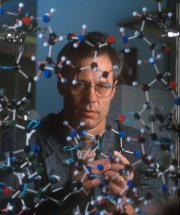
loren.williams@chemistry.gatech.edu
Website
- Loren Williams is from Seattle. He received his B.Sc. in Chemistry from the University of Washington, where he worked in the laboratory of Martin Gouterman. He received his Ph.D. in Physical Chemistry from Duke University, where he worked the laboratory of Barbara Shaw. He was an American Cancer Society Postdoctoral Fellow at Harvard, and an NIH Postdoctoral Fellow at MIT with Alexander Rich. He is currently a Professor in the School of Chemistry and Biochemistry at Georgia Tech. Loren is a Fellow of the AAAS and of the International Society for the Study of the Origins of Life. He was previously Director of the NASA Astrobiology Institute funded RiboEvo Center and is currently Director of the NASA-funded Center for the Origins of Life (COOL). Loren is currently a Co-Lead of the Prebiotic Chemistry and Early Earth Environment Consortium (PCE3 a NASA Research Coordination Network). Loren has received the following awards:
- 1995 NSF Career Award
- 1996 Sigma Xi Best Paper from Georgia Tech
- 2012 Georgia Tech Student Advisement Award
- 2012 Petit Institute Above and Beyond Award
- 2013 Georgia Tech Faculty Award for Academic Outreach
- 2013 Georgia Tech College of Science Faculty Mentor Award
- 2017 Access Alley Award from Georgia Tech Disability Services for advocating for handicapped students
- 2019 Vasser Woolley Award for Excellence in Instruction
- 2020-21 Georgia Tech Outstanding Achievement in Research Program Development
- 2021 Fellow of the International Society for Study of the Origin of Life
- 2021 Petit Institute Above and Beyond Award
- 2022 College of Sciences, Faculty Mentor Award
- 2023 Fellow of the AAAS
Professor
Director, Center for the Origin of Life
Phone
404-385-6258
Office
Petit Biotechnology Building, Office 1309
Additional Research
We study folding and structure of RNA and DNA as modulated by sequence, covalent damage, anti-cancer drugs, proteins, other nucleic acid molecules. The oldest assembly in biology is the ribosome, which is a primary focus of our efforts. Ancient ribosomal structure and function, from beyond the root of the tree of life, can be inferred from extant structure/function combined with phylogeny, evolutionary theory, biophysical chemistry, bioinformatics and molecular biology. We use all of these approaches to construct models of ancient ribosomes, which we then study by biochemical methods. Three-dimensional structure, being more conserved over evolutionary time than sequence, offers some of the most important guideposts in our journeys down the base of the tree of life.
Research Focus Areas
IRI And Role
University, College, and School/Department
Google Scholar
https://scholar.google.com/scholar?q=Williams,+Loren+D&btnG=&hl=en&as_sdt=0,11
Loren
Williams
Show Regular Profile





